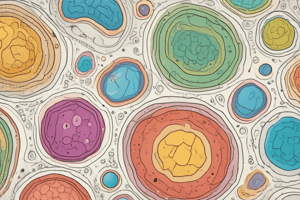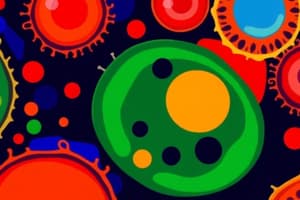Podcast
Questions and Answers
Which organelle is primarily responsible for regulating what enters and leaves the cell?
Which organelle is primarily responsible for regulating what enters and leaves the cell?
- Mitochondria
- Cell Membrane (correct)
- Nucleus
- Cell Wall
What is the main function of the mitochondria within a cell?
What is the main function of the mitochondria within a cell?
- Chemical energy production (correct)
- Strong support
- Assists in protein synthesis
- Controls cell activities
Which organelle is involved in the production of ribosomes?
Which organelle is involved in the production of ribosomes?
- Nucleolus (correct)
- Nucleus
- Rough Endoplasmic Reticulum
- Smooth Endoplasmic Reticulum
Which two components make up the cytoskeleton?
Which two components make up the cytoskeleton?
What is the function of ribosomes in a cell?
What is the function of ribosomes in a cell?
Flashcards are hidden until you start studying
Study Notes
Cell Wall
- Provides structural support and protection to plant cells, bacteria, fungi and some protists.
Cell Membrane
- Regulates the passage of substances into and out of all cells.
- Composed primarily of phospholipids.
Nucleus
- Contains the cell's genetic material, DNA, in the form of chromosomes.
- Controls cellular activities, including growth, metabolism, and reproduction.
Nucleolus
- Site of ribosome production.
- Located within the nucleus.
Ribosome
- Assists in building proteins.
- Found in all cells.
- Can be free-floating within cytoplasm or attached to the rough endoplasmic reticulum.
Smooth Endoplasmic Reticulum (SER)
- Synthesizes lipids (fats) and steroids.
- Detoxifies harmful substances.
- Stores calcium ions for cell signaling.
Rough Endoplasmic Reticulum (RER)
- Modifies and transports proteins made by ribosomes attached to the ER.
- Synthesizes phospholipids.
Mitochondria
- The powerhouse of the cell.
- Produces ATP, which is the cell's primary energy source.
- Found in all eukaryotic cells.
Cytoskeleton
- Provides structural support for the cell.
- Plays a role in cell movement, intracellular transport, and cell division.
- Composed of two main components:
- Microtubules: Long, hollow tubes made of tubulin protein.
- Assist with movement of chromosomes during cell division.
- Form the basis of cilia and flagella.
- Microfilaments: Solid, thin rods composed of actin protein.
- Play a role in muscle contraction and cell shape changes.
- Facilitate cell crawling.
- Microtubules: Long, hollow tubes made of tubulin protein.
Studying That Suits You
Use AI to generate personalized quizzes and flashcards to suit your learning preferences.





